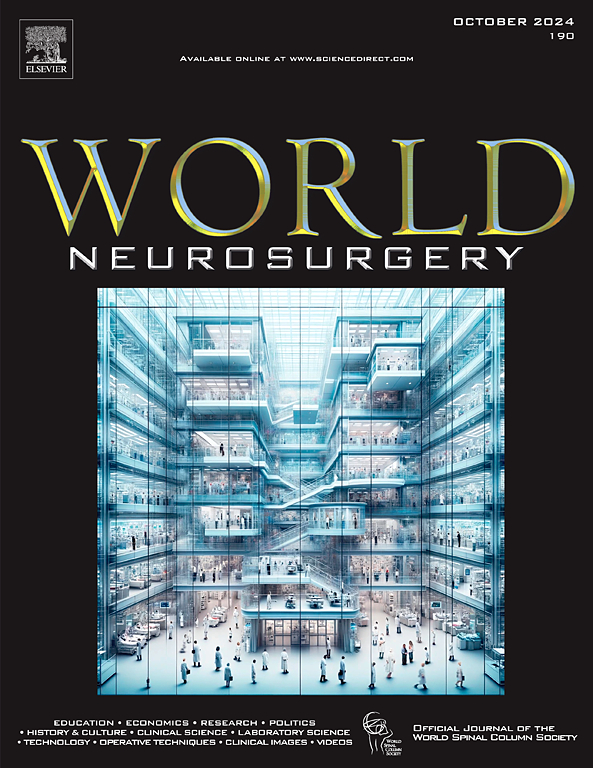Application of Multimodal Image Fusion 3D Reconstruction Technology Combined with 3D Printing Guide Plate in Meningioma Surgery
IF 1.9
4区 医学
Q3 CLINICAL NEUROLOGY
引用次数: 0
Abstract
Objective
To explore the value of multimodal image fusion three-dimensional (3D) reconstruction technology combined with 3D-printed guide plates in meningioma surgery.
Methods
The clinical data of 16 patients with meningioma who underwent tumor resection at Taizhou People's Hospital between November 2022 and May 2024 were retrospectively analyzed. Preoperative thin-layer computed tomography and magnetic resonance imaging examinations were performed on all patients. Multimodal image fusion and 3D reconstruction were performed on the computed tomography and magnetic resonance imaging data using the 3D Slicer software to create 3D models of the skin, muscle, skull, tumor, cerebrovascular structures, and other relevant anatomical features. These models were used to develop optimal surgical plans and design 3D guide plates. The 3D printing guide promoted precise localization of the tumor on the body surface, assisted in the design of the bone flap and scalp incision, and identified key surgical landmarks. General data, results of multimodal image fusion 3D reconstruction, accuracy of the 3D printing guide, intraoperative data, surgical complications, and follow-up outcomes for all patients were summarized.
Results
The surgical approach was successfully planned, and 3D-printed guide plates were created preoperatively based on the multimodal image fusion and 3D reconstruction models. The 3D guides enabled precise body surface localization of the tumor and full exposure of the tumor and peritumoral tissue with the smallest possible bone window. Multimodal image fusion 3D reconstruction images promoted the successful protection of important cerebrovascular structures and brain tissue during surgery. All 16 procedures were successfully completed, with the 3D reconstructed images closely matching the intraoperative observations. The tumor was accurately located beneath the incision and postoperative imaging confirmed complete lesion removal.
Conclusions
Multimodal image fusion combined with 3D printing guide technology provides precise localization for meningioma resection, aids in understanding the position of cerebrovascular structures and the skull, prevents deviations in the surgical pathway, optimizes the surgical process, predicts potential intraoperative challenges, increases the success rate of surgery, and decreases the rates of complications and recurrence.
求助全文
约1分钟内获得全文
求助全文
来源期刊

World neurosurgery
CLINICAL NEUROLOGY-SURGERY
CiteScore
3.90
自引率
15.00%
发文量
1765
审稿时长
47 days
期刊介绍:
World Neurosurgery has an open access mirror journal World Neurosurgery: X, sharing the same aims and scope, editorial team, submission system and rigorous peer review.
The journal''s mission is to:
-To provide a first-class international forum and a 2-way conduit for dialogue that is relevant to neurosurgeons and providers who care for neurosurgery patients. The categories of the exchanged information include clinical and basic science, as well as global information that provide social, political, educational, economic, cultural or societal insights and knowledge that are of significance and relevance to worldwide neurosurgery patient care.
-To act as a primary intellectual catalyst for the stimulation of creativity, the creation of new knowledge, and the enhancement of quality neurosurgical care worldwide.
-To provide a forum for communication that enriches the lives of all neurosurgeons and their colleagues; and, in so doing, enriches the lives of their patients.
Topics to be addressed in World Neurosurgery include: EDUCATION, ECONOMICS, RESEARCH, POLITICS, HISTORY, CULTURE, CLINICAL SCIENCE, LABORATORY SCIENCE, TECHNOLOGY, OPERATIVE TECHNIQUES, CLINICAL IMAGES, VIDEOS
 求助内容:
求助内容: 应助结果提醒方式:
应助结果提醒方式:


